For as long as I can remember, until I really begun to understand nutrition, I’d never really felt 100%. Although I wasn’t sick, I spent years always feeling a little bit below par. I’d come to accept this as a way of life…
“surely everyone feels like this right?”
“It’s probably unrealistic to feel alert and ready for the day ahead”
“Everyone else probably struggles with feeling a bit tired all the time…”
“I’m just not a morning person..”

This acceptance of this state carried on and on for far too long before I was introduced to the field of nutrition by a registered and clinical nutritionist who worked for a medical clinic in the prestigious Harley Street in London.
But what actually is a clinical nutritionist?
Clinical Nutrition, according to the formal definition is “the study of the relationship between food and a healthy body. More specifically, it is the science of nutrients and how they are digested, absorbed, transported, metabolized, stored, and eliminated by the body.” [1]
A dietitian on the other hand are individuals who “assess, diagnose and treat dietary and nutritional problems at an individual and wider public-health level.”
There is a significant overlap in both of these fields. To try and compare the two, clinical nutritionists focus much more about food quality and how this may impact the body and an individual’s well-being. They are more likely to take a holistic view of health, taking into account environmental factors. Nutrition supplementation may also feature in their recommendations.
A dietitian on the other hand may be more likely to work in a hospital and implement reactive strategies to an individual’s problems. A dietitian may typically ignore themes such as detoxification and may be more likely to serve a client something processed, served with a “sugar free” soda [2]. Unfortunately I’ve seen the work of poor dietitians on my own family.
Now we’ve got the definitions out of the way, what are the top nutrition tips which can help you get rid of that brain fog, be more alert throughout the day and generally feel better? They are all below!
However, before you start, the best way to improve your health and well-being is through making small positive changes one at a time. Try to change too much and you’re much more likely to find it unsustainable and revert back to old habits.
Ready to go…? Awesome! Simply read on and start improving your health and well-being today!
Top Nutrition Tip 1 – Assess How You Feel
Every day is often not what it should be for many people, whether it’s that alarm going off when you still feel exhausted or simply feeling “not your normal self”.
This is not how it should be. Vibrant health, a clear mind and stable energy throughout the day are what our everyday realities should feel like. It is our lifestyles, from our training and work, to our sleep, and especially our nutrition – which can be the best preventative medicine available.
One of the key reasons the latest diet fad or celebrity nutrition recommendation doesn’t quite delivery what you wanted is the fact that each of our bodies, whilst in many ways are very similar, are also very different.
Different hormonal balances, exercise levels, stress levels and a range of other environmental factors can influence the nutrition we need to feel at our best. Apart from the age old wisdom of eat your vegetables and make sure your exercising multiple times a week, the rest of the dietary advice you’ll hear in magazines and even the darkest corners of the internet, simply won’t work for you.So how on earth are we supposed to know the best things for us to eat on a daily basis?!

This is a question that comes up over and over again and unfortunately there is no “out of the box” solution that works for everyone. The best way to assess whether specific foods should feature as part of your weekly diet is to simply assess how you feel.
As I very basic example, unsurprisingly, I’ve always felt particularly sluggish following eating an unhealthy fast food meal. Alternatively, (and again unsurprisingly) I’ve often felt much perkier with a meal consisting of kale, other mixed vegetables and organic meat.
For you it may be something else which causes your energy to crash after 2pm, maybe its chocolate, chips or simply too many carbohydrates at lunchtime. Maybe it’s sandwiches that leave you hungry again an hour later.
We’re not going to sit here and tell you to cut anything out of your diet as any particular treat can be enjoyed in moderation as part of a healthy lifestyle. Unfortunately however, the hard part is up to you to decide how you feel after eating particular foods.
Only through truly assessing how you feel after eating certain foods can you really begin to understand your body and the foods which can help you feel at your best.
Whether you do this through a written diary or another system such as myfitnesspal, the process of self-experimentation is an important road for each individual to walk. Start by taking out particular foods and replacing them with other food and noting how you feel.
Sadly this list for you does not yet exist, it’s not in a recipe book, nor is it through following celebrity chefs, because it is unique to you. Luckily, there are some common principles and simple tips below to get you started.
Progressing along your own experimental food journey will give you a list of foods that leave you feeling awesome. Once you have this list, you can build your own personal menu to ensure you feel at your best every day.
Top Nutrition Tip 2 – Avoid Chemical Calories
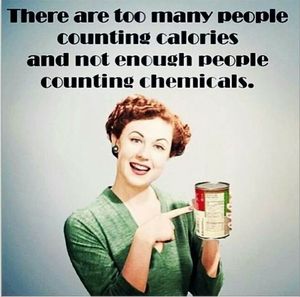
Modern food production has evolved significantly over time. Once would get our local meat, dairy, fruit and veg from the farmer that lived down the road.
Now with modern technology, we can easily go to our nearest supermarket to have food delivered which has been grown and reared all over the world.
Great right? Add on the convenience of online shopping and you can choose the food you eat from wherever it is in the world.
However, not all advancements have been in the interest of our health, many of them now contain “chemical calories”…
Take fruit and vegetables to start. Fruit and vegetables with imperfections don’t often sell particularly well. Neither does food that has a very short sell-by date. The solution? Pesticides & genetic modification.
Now looking at animal products, larger cows can provide more beef and so growing cows quicker can result in much more profit for the owner. The “solution”? Growth hormones, antibiotics and preservatives as the meat is sent across borders.
Unsurprisingly, humans are not designed to eat chemical calories such as preservatives and pesticides, and we definitively shouldn’t be subject to various hormones which may come from non-organic animal products.
Using the formal definition of pesticides as:
“A pesticide is any substance or mixture of substances intended for preventing, destroying, repelling, or mitigating any pest (epa.gov). Pests can be defined as any organism that causes plant diseases. Agricultural pesticides are then those chemicals that are used by farmers to prevent the efficacy of the pests on the growth and productivity of agricultural crops.”
We know they can have significantly negative effects on human health. Exposure to pesticides can also result in cell toxicity and a reduction in optimal cell function [3].
A July 2007 study conducted by researchers at the Public Health Institute, the California Department of Health Services, and the UC Berkeley School of Public Health found a sixfold increase in risk factor for autism spectrum disorders (ASD) for children of women who were exposed to organochlorine pesticides [4].
bad effect
Preservatives, whilst useful for ensuring that our food doesn’t spoil as quickly, also comes with it’s unknown health warnings.
According to the Center for Science in the Public Interest, animal studies reveal that low doses of propyl gallate, a common preservative, may increase risk of cancer. Additionally, a double blind and placebo controlled study demonstrated significant increases in hyperactive behavior when children were given additives and preservatives [5].
With regards to the addition of hormones to the the meat supply, a further study in 2007 concluded the following: “maternal beef consumption, and possibly xenobiotics in beef, may alter a man’s testicular development in utero and adversely affect his reproductive capacity” [6].
Note – this is not an article designed to scare you. This article is simply here to try and give you as much information as is possible so that you can make the best decisions for yourself and your family.
Despite some potentially worrying studies, the consumption of non-organic foods is unlikely to cause any significant health implications in the short term so there’s no need to run to your fridge to throw everything out straight away!
Unfortunately, organic foods are typically more expensive and may prove too costly for some households, your local supermarket may not even have a great selection of organic foods. If this is the case, try to make some small changes where possible.
As an example, I consume a proportion of my daily protein requirements from eggs, I therefore try to always ensure my weeks supply of eggs is organic, even though 100% of my meat may not be.
Small changes will yield positive results over time, so don’t lose sleep if the perfect shopping list isn’t possible.
There are also some simple initiatives you can implement in your lives to increase the rate at which your body deals with “chemical calories”, including, buying a couple of plants for the home, keeping plastic out of microwaves and increasing your fiber intake.
Naturally, eating more fruit and vegetables will also help counteract any damaging effects of chemical calories.
Try downloading the poster below and you can even see which fruit and vegetables you can safely buy non-organic. Stick it on your fridge for your whole family to see!
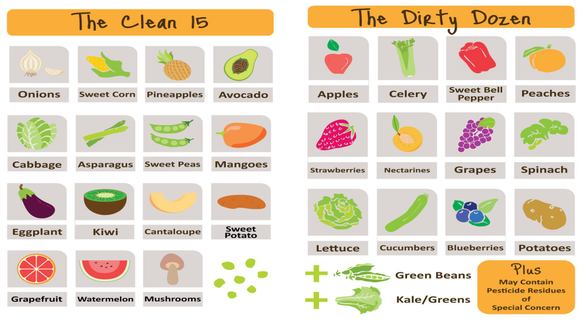
Top Nutrition Tip 3 – Lower Liver Toxicity
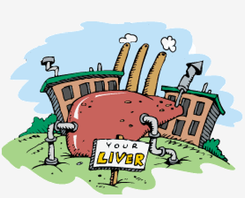
The modern diet presents a whole range of daily challenges to our liver and can often reduce the extent by which the liver can complete it’s usual functions.
First, let us quickly review what the liver actually does…
It’s quite an impressive organ. It combats infections, manufactures bile, stores iron, vitamins and other essential nutrients, manufactures hormones, regulates blood sugar and is responsible for making various enzymes which are responsible for a whole range of chemical reactions in the body, e.g. blood clotting and repairing damaged tissue.
In addition to the impressive range of functions that the liver performs, it’s also breaks down and detoxifies substances in the body including alcohol, drugs, food additives and chemical calories as referred to in tip 3.
It might be useful to think of an office worker who completes a range of functions for a business including creating documents, completing calculations, setting up meetings etc, think of these as the important jobs for the office worker to do.
The office worker (i.e. our liver) also has a phone which needs to be picked up whenever it rings, think of this as the toxins that we ingest on a day to day basis such as sugar, trans fats, alcohol and excess caffeine.
Toxins are…well… toxic (no surprises there!), so therefore our body targets these as a priority to deal with. Unfortunately, many modern diets contain so many toxins that the liver might have a difficult time to process whilst also completing its other processes.
Consider our office worker, modern diets consisting of frequent alcohol consumption, fast food and unhealthy snacks, mean that the office worker spends so much time on the phone dealing with immediate problems that there simply isn’t enough time to do the other tasks that need to be done.
If we we’re able to reduce the times the phone rings each day, our office worker would have much more time to do great work on helping complete calculations and book important meetings.
To think back to this in terms of our liver again, if we reduced the amount of toxins in our diets, our liver would have much more time and energy to complete other important functions including making vital enzymes or storing vitamins.
Some of the key toxic substances we would want to avoid include:
- Excess sugar
- Trans fats (i.e. fast / deep fried food)
- Regular alcohol consumption (see tip 4)
- Excess caffeine (i.e. more than 4 cups of coffee / day)
- Additives, preservatives, herbicides, pesticides and pollutants (see tip 2)
This would result in a better performing liver, leading to a healthier and happier you.
FACT – The liver contributes to more than 500 vital functions and enzymatic actions in the body.
Top Nutrition Tip 4 – Watch your Alcohol Intake

Most countries in the world (and even parts of the animal kingdom) likes a drink (or several) every now and then, whether you’re celebrating a new promotion, a friends birthday or simply winding down from the week, the drinks can quickly begin to flow.
Now this section isn’t trying to scare you, alcoholic drinks in moderation can feature as part of a healthy lifestyle. The problem obviously occurs when moderation goes out of the window and you find yourself throwing up outside of your favorite club or texting that person you end up regretting in the morning.
Apart from the obvious, even casual drinking can have significant effects on your health.
We already know how the liver can often be overworked by unhealthy chemicals it has to produce, alcohol is no different.
In terms of toxicity, alcohol is converted into acetaldehyde (toxic compound 1) and reactive oxygen species (toxic compound number 2). Like free radicals (covered in top nutrition tip 9), these can damage DNA, protein function and important fat structures within the cells.
This can then lead to cell death, inflammation and damaged DNA. In addition to this, it makes the job of the liver so much more difficult. Imagine our struggling office worker, dealing with alcohol toxicity is the equivalent of turning the office workers computer off at random intervals throughout the day – not helpful and very frustrating…
“I did dry January this year so I don’t need to worry…”
Sadly, 1 month of going drink free doesn’t make you any better off if you drink regularly throughout the rest of the year. Instead of a 1 month drinking ban, try to incorporate at least 3 consecutive days without drinking any alcohol every week.
This will help keep your liver from feeling overloaded, it’s as if you’re giving your internal office worker more time to get things done for a few days!
Top Nutrition Tip 5 – Eat the Rainbow
When falling into a routine, its easy to keep things the same. Very often we may find our favorite product and rarely mix things up for fear that it just won’t be quite as good.
The same is true for vegetables. I’m even guilty of falling into my typical routine of green vegetables almost daily. When doing this however, we deprive our bodies of various compounds that are beneficial which our favorite vegetables might not have in sufficient quantities.
Ensuring we eat the colors of the rainbow can fuel our systems with a wide variety of antioxidants. Aim to eat a range of different colored fruit and vegetables throughout the week:
Red
Tomatoes, beetroot, pink grapefruit, watermelon, strawberries, red peppers, raspberries, apples, adzuki and kidney beans, blood organes, cranberries, cherries, goji berries, grapes, onions, plums, pomegranate, potatoes, radishes, rhubarb, rooibos tea, red rice red quinoa.
All of these foods have reported anti-inflammatory, anti-cancer, gastrointestinal, heart, hormonal and liver health benefits.
Yellow
Banana, lemon, corn, peppers, pineapple, ginger root, star fruit, squash, yellow chard, corn on the cob, apples, yellow courgettes, honeydew melon, yellow tomatoes.
These foods have anti-cancer, anti-inflammatory, cell protective, eye, heart, skin and vascular health benefits.
Orange
Carrots, mangoes, apricots, cantaloupes, pumpkin, acorn squash, winter squash, sweet potatoes, red lentils, turmeric, oranges, tangerines, peachess, papayas, nectarines, yams, bell peppers.
These foods contain anti-cancerr, anti-bacterial, immune supportive, reproductive and skin health benefits.
Green (my favorite!)
Broccoli, brussels sprouts, cabbage, Chinese cabbage, bok choi, kale, artichoke, asparagus, avocado, bean sprouts, peppers, melon, celery, cucumber, edamame, green beans, green peas, green tea, chard, lettuce, spinach, limes, okra, pear, watercress, courgette, olives.
These foods have anti-inflammatory, anti-cancer, neurological, hormonal, heart, liver, and skin health-boosting properties. For more information why you should always eat something green every day – see here for a full list of health benefits.
White, Brown and Beige
Leeks, scallions, garic, onions, celery, pears, endive, dates, cauliflower, mushrooms, nuts, ginger, cocoa, coconut, coffee, tahini, tea, sauerkraut, seeds, chickpeas, borlotti and butter beans, hummus.
These foods contain anti-cancer, anti-microbial, gastrointestinal, heart, hormone and liver health benefits.
Blue, Indigo, and Violet
Blackberries, blueberries, blackcurrants, figs, purple grapes, plums, prunes, raisins, purple broccoli, aubergine, purple potatoes, cabbage, onions, kale, olives, rice, carrots, cauliflower.
These foods have anti-cancer, anti-inflammatory, cognitive, heart, skin and liver health boosting properties.
So next time you’re out at the supermarket, try and put at least 4 different colors of fruit and vegetables in your basket, or if you’re feeling up to the challenge, try to have a selection of fruit and vegetables from the entire rainbow!Have a favourite recipe? Leave a comment below – we’d love to hear from you!
FACT – The wonderful colours in vegetables and fruits represent over 25,000 different phytonutrients.
Top Nutrition Tip 6 – Go Alkaline
First – let’s have a quick recap of high school science: all compounds sit on a scale from 0-14 to identify how acidic or alkaline the compound is. Compounds with a pH below 7 are noted as acidic, for example battery acid with a pH of 0. Compounds with a pH above 7 are noted as alkaline, for example liquid drain cleaner with a pH of 14.
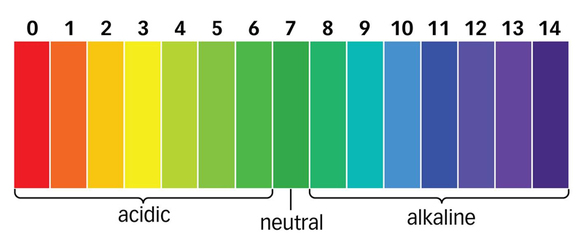
Overall, most liquids and foods sit somewhere well between these two extremes, though a modern diet consisting of animal protein, dairy and sugars can lead the body to become more acidic.
In the body, the higher the pH level, the more alkaline your internal body fluids are. This is great for your body as it supports a higher oxygen supply.
It has even been noted that “An alkaline body can absorb up to 20 times more oxygen than an acidic body” says Dr Otto Warburg, Nobel Prize Winner.
Conversely, an acidic pH does not support an oxygen rich environment – no guesses that this is bad news for our bodies!
Of course this is no reason to avoid animal products or dairy (sugar on the other hand can always be reduced!), as so long as these food are consumed within a healthy lifestyle and balanced with alkaline foods, you can enjoy great health.
Most of the time, fruits and vegetables are a rich source of alkaline properties, but which foods are the best to reduce the extent by which our internal pH becomes acidic?
Lemons – lemons contain a pH level of 9.0* and are rich with electrolytes which can support the body’s strength and endurance during exercise.
Cayenne – has a pH level of 8.5 and is high in enzymes that are essential in the endocrine system (the collection of glands that produce hormones). It’s also a fantastic source of vitamin A. Why not sprinke a little over your next meal for an extra health boost?
Mango, Melons, Papaya – with not only a pH level of 8.5, these food are also vitamin-rich fruits that also support colon cleansing.
Asparagus – with a pH level of roughly 8.5, this vegetable greatly lowers the acidity in the body. Asparagus also contains asparagines which is an important amino acid in the nervous system.
Grapes, pineapple – this food group contains a pH level of 8.5. Grapes are one of the wonder fruits that are rich in anti-oxidants as well as in vitamins A, B and C. Pineapple on the other hand, is rich in fiber and antioxidants that can help you to trim fat and contour your shape.
Apples – “an apple a day, keeps the doctor away”. With a pH level of 8.0, apples can lower the level of acidity in the body. Apples are also rich in enzymes that can keep the body’s hormones balanced.
Bananas, Berries, Garlic – this food group contains a pH value of 8.0 and is very rich in antioxidants. Garlic and berries can also help in regulating blood sugar.
Turmeric – whilst being a great addition to your diet for all-round health, can also be used as a rough indicator for the pH level of other foods. When you put turmeric in foods that have a pH value under 7.4, the turmeric will turn yellow. In foods with a pH above 8.6, it turns red!
Red Pepper – sitting at a pH of roughly 7.5, bell peppers also contain about 3 times more vitamin C than an organge. Vitamin C is one of the creams of the vitamin crop because it transforms toxins into digestible material.
*Lemons are often a surprise when it comes to being an alkaline food. Lemons are citrus fruits and the pH of lemon juice is typically around 2 (highly acidic), however, when lemon juice has been fully metabolized in the body and its minerals are dissociated in the bloodstream, its effect is alkalizing and therefore raises the pH of body tissue!
FACT – Eating alkaline foods are of vital importance in the renewal & restoration process of the body as well as preventing the build up of lactic acid detrimental to health.
Top Nutrition Tip 7 – Stay Hydrated
Hydration is a topic which is so often overlooked, yet is is potentially the most important factors for optimal health, performance and wellbeing.
The human body is made up of between 45-70% water, usually around 60%. For a typical 70kg adult, that is around 42kg (or 42L) of water!
When we forget to drink enough water, we can easily become dehydrated. Dehydration occurs when your body loses more fluid than it takes in and means that your body doesn’t have enough fluid to carry out normal functions.
Not only will this contribute to headaches, dizziness and weakness, but it can also create the illusion that you are hungrier than you really are. This combined with a disruption to the way to digest food can mean you eat more food than is necessary and will make you more likely to put on weight.
A great habit to get into is to drink a glass of water before you eat any food, whether its a meal or a snack. Lots of the time you’ll realize you’re not as hungry as you thought you were and can therefore reduce the amount of calories you eat.
This will not only help you maintain a lean physique, but will also help with digestion and ensure that your body has enough fluid to carry out normal functions.
You can also compare your urine to the chart below to see if you’re dehydrated. You can download it for free and place it above your toilet at home too, you may get a few strange looks from your guests but at least everyone will be encouraged to drink water!
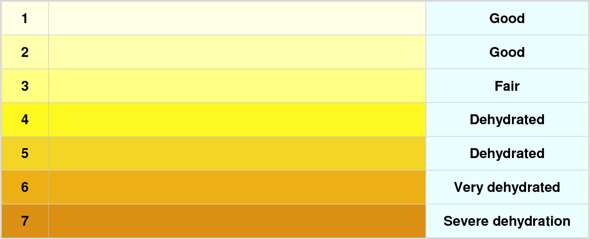
So how much water is enough?
As with most aspects of health, it will vary from individual to individual (hence tip #1 – assess how you feel!). Fortunately, there are some rough guides you can use that should ensure you don’t fall too far off track.
There is of course the old wisdom that we should drink eight 8 ounce glasses of water a day, whilst this is fairly outdated advice, it’s much better than only drinking 7 glasses of water a day!
More modern advice, gives water consumption by age and gender, with female adults consuming around 2.7L per day and male adults consuming 3.7L per day.
Though this is good advice for the average person, you are not the average person. To get a more accurate estimate you would use this as a guide, but then adjust your water intake depending on a range of factors including:
- The temperature
- Your level of exercise during the day
- The amount you’ve sweated
By combining this rough guide with drinking water whenever you a) feel thirsty or b) before food. You’re giving yourself the best chance possible of making sure you never go below a 3 on the dehydration chart above!
Top Nutrition Tip 8 – Try Intermittent Fasting
Fasting has long been known to be of significant health benefits. It’s been practiced by several religions throughout history and is a great way for the body to “detox” itself (bearing in mind the liver is always removing toxins from the body!).
So what is it about fasting that’s so good? And how does intermittent fasting exactly work?
Fasting as a practice has fairly impressive effects on a range of body functions including:
- Improves insulin sensitivity
- Supports removal of poor habits (e.g. smoking)
- Gives your digestive system a prolonged break
- Reduces inflammation
- Facilitates fat as the primary source of energy
Fasting is typically done by going for long periods (12 hours+) with no food or calories. Typically many religions practice fasting by eliminating water during this period, however to purely reap the health benefits this is not necessary.
For those new to fasting, simply stopping eating for 12, 16, 20 hours or even more is a huge jump from the modern diet. Fortunately, you can reap all the benefits of fasting by embedding intermittent fasting into your weekly schedule.
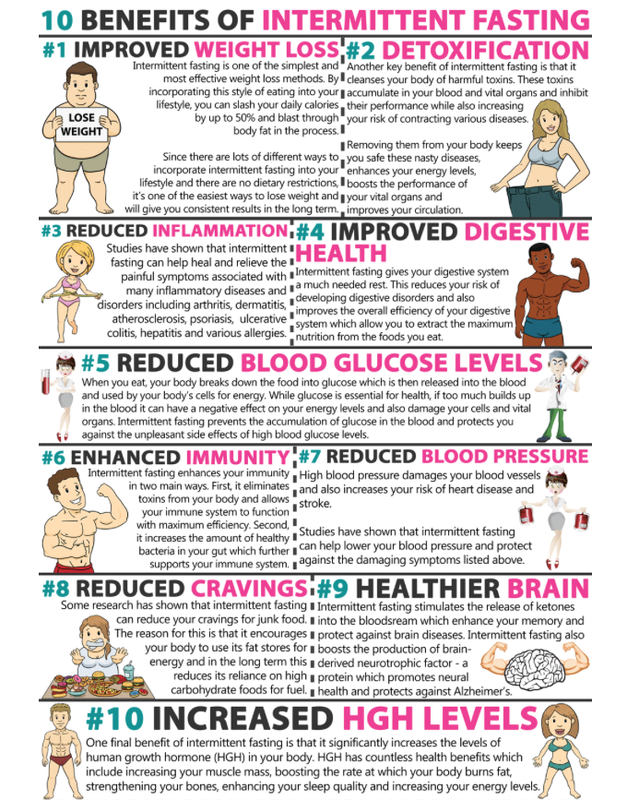
But what IS Intermittent Fasting (IF)?
Intermittent fasting (IF) is simply shorter periods of fasting, embedded within a normal eating regime. There’s a whole range of ways to do it including skipping a day of meals a week, the 5:2 diet, which recommends very low calorie days on the weekend, any my personal favorite leangains.
Leangains recommends a typical daily eating window of 8 hours, meaning your body will be fasting for roughly 16 hours a day. Whilst this sounds like quite a bit, you should be sleeping for about 8 out of those 16 hours!
A typical day might look something like this:
- 7 am – Wake up @ drink black coffee
- 8 am – Work
- 12 am – Eat the first meal of the day (e.g. boiled eggs)
- 3 pm – Eat pre-workout meal (e.g. quinoa, vegetables, and protein)
- 5 pm – Workout (strength or HIIT training ideally)
- 6 pm – Eat post-workout meal (biggest meal of the day – 1,000 calories+)
- 7:30 pm – Healthy dessert (e.g. berries & yogurt)
- 10:30 pm – Sleep
Before I get a hundred messages of “I don’t finish work at 5….” (if you do, I’m very jealous and might have to change career at some point!) or “I need to work out in the morning”, don’t worry.
Intermittent fasting, by its very nature is designed to be FLEXIBLE and work around you. If you want to work out in the morning? Go for it! If you can’t workout till 9pm? Not a problem!
The simplest way to make IF work for you is build it around YOUR schedule and commitments, e.g. if you work out in the morning your schedule may look something like this:
- 6 am – Wake up and workout
- 7 am – Post-workout meal (biggest meal of the day with high protein)
- 10 am – Snack (e.g. nuts / eggs / fruit)
- 1 pm – Lunch with work colleagues (e.g. protein and vegetables)
- 2:30 pm – Final meal of the day (e.g. cottage cheese with sweet potato)
- 10 pm – Sleep
Whatever your schedule or your commitments, you can make an IF program work to fit your needs, to start, simply try extending your fasting window by having your last meal an hour earlier or your first meal of the day an hour later.
Start slowly – you also don’t need to do the full 16 hours every day if you don’t feel up to it, you’ll still get benefits from 15 and even 14 hours of fasting per day. Alternatively, if you could also scale up to 17, 18 or even more hours of fasting once you’re comfortable with the process.
(Note: If you or anyone you know has any potential eating disorders, this isn’t for you, please seek professional help from the support services in your area)
A quick note on the Myths in the fitness industry regarding eating patterns:

Whenever talking about IF, people usually have a number of popular misconceptions. The most common being;
1) Eat frequently to “stoke the metabolic fire”
2) Skipping breakfast is bad and will make you fat
3) Fasting tricks the body into “starvation mode”
4) Maintain a steady supply of amino acids by eating protein every 2-3 hours. The body can only absorb 30 grams of protein in one sitting.
We’ll tackle these individually – though if you’re keen more more details on the science of fasting and popular misconceptions, you can find more information here.
1) Eat frequently to “stoke the metabolic fire”
Every time you eat, you do burn some calories actually digesting the food, this is known as the Thermic Effect of Food. Logically then, we could assume that eating little meals constantly would help keep this effect going so that we would be spending energy throughout the day on digesting food or “keeping our metabolism fired up”.
In reality, this is not the case. The amount of energy it takes to digest food is directly proportional to the amount that you eat. Therefore, whether you eat 1 huge meal of 1,000 calories, or 4 smaller meals of 250 calories (a total of 1,000) you will burn exactly the same amount of calories through digestion.
2) Skipping breakfast is bad and will make you fat
Many studies on those who skip breakfast focus on individuals who have a haphazard approach to their own personal nutrition and don’t take an interest in learning more about effective nutrition (not you essentially!).
The benefits of eating breakfast is that you eat when your body is sensitive to insulin, i.e. your body will absorb carbohydrates into the muscles for energy rather than storing them as fat.
But this insulin sensitivity is due to the fact you haven’t eaten for 8-10 hours and not because the morning is some magical time of day. This same effect will happen if you break your fast (read: “breakfast”) at 10am, 12am, 2pm or 4pm and so the argument for eating in the morning doesn’t hold any value.
As ever, food quality is paramount, kick off your day with some chocolate croissants or pancakes for breakfast and you’re on a slippery slope to clogged arteries.
3) Fasting tricks the body into “starvation mode”
The body going into “starvation mode” was an important adaption in our evolution, allowing us to conserve energy before we were able to hunt our next meal.
Typically, we don’t ever have to wait that long for our next meal. The body kicks off “starvation mode” once we’ve gone over 60 hours without food (or 2.5 days), but not before then.
Unless you’re planning fasting for more than 2.5 days, don’t worry about your body going into “starvation mode”.
4) Maintain a steady supply of amino acids by eating protein every 2-3 hours. The body can only absorb 30 grams of protein in one sitting.
The whole “we can only absorb 30 grams of protein in one sitting” muth came from a study which quantified how quickly whey and protein can be absorbed. The result? It turns out that 30 grams of whey protein can be absorbed within 3-4 hours for a fasted individual (someone who hasn’t eaten in over 8 hours).
However, this doesn’t actually mean that we can only absorb 30 grams of protein in 1 sitting, or that we need to eat every 2-3 hours. If you take a standard meal of 75g of carbohydres, 37g of protein and 17g of fat, it would still be digesting after 5 hours.
Switch that meal to a steak with a big pile of vegetables (75g or protein, 30g of carbs and 30g of fat) and you’ll absorb all the nutrients, just over a longer period of time!
I’ve personally used IF for nearly two years now and find it’s been really easy to build into my daily schedule. I’ve found it to be incredibly convenient in the mornings where I can simply grab a glass of water and then head to work without needing that extra 20 minutes to create and eat a healthy meal at 7am!
Top Nutrition Tip 9 – Get More Antioxidants
When I was younger (and considerably less informed), I’d never really understood antioxidants. “but we breath oxygen – so why would we want something that is anti-oxygen? Surely we always want more oxygen in our body, right?”
It turns out I was completely wrong, although oxygen is one of the most important components for life, it is also a highly reactive atom that is capable of becoming part of potentially damaging molecules often known as “free radicals”.
Free radicals can attack healthy cells within the body, leading to damage, disease and severe disorders. Free radical damage in the cells is also a major contributor to diseases such as; cancer, heart disease, reduced brain function and a reduction in the immune system, among other negative effects.
Pretty awful. Fortunately, antioxidants exist which are capable of deactivating free radicals before they can cause damage to our cells!
Some of the most popular antioxidants are Vitamin C, Vitamin E and Beta Carotene (linked to Vitamin A)
Vitamin C – Vitamin C is the most important water-soluable antioxidant and help to neutralize harmful components in our bodies including free radicals.
- 5 of the best sources of Vitamin C include; Bell peppers, Kale, Kiwi, Broccoli and Strawberries..
Vitamin E – Vitamin E is the most important fat soluable antioxidant, it can protect the cell membrane from oxidizing.
- 5 of the best sources of Vitamin E include; Sunflower seeds, almonds, spinach, asparagus and avocados.
Beta Carotene – In the body beta-carotene converts into Vitamin A which contributes to good vision and overall eye health, boosts the immune system and is a powerful antioxidant.
- 5 of the best sources of Beta Carotene include; Sweet Potato, Carrots, Spinach, Butternut Squash and Cantaloupe Melon.
Next time you’re at the supermarket, try to put some of these antioxidant powerhouses into your shopping basket!
Top Nutrition Tip 10 – Exercise
No big surprises here!
Not only is exercise important because…… it works as an antidepressant,
… it reduces PMS,
… it reduces stress and anxiety,
… it boosts creativity,
… it wipes out allergies,
… it strengthens your heart,
… it helps resist temptation,
… it reduces risk of metabolic syndrome,
… it reduces the risk of lots of other diseases,
… it protects your eyes,
… it adds years to your life,
… it makes you happier,
… it increases gratitude,
… it strengthens bones,
… it’s cheap,
… it improves fertility,
… it improves sexual performance,
… it improves self-esteem,
… it helps you sleep,
… it slows down cellular aging,
… it improves coordination,
… it burns fat,
… it boosts intelligence,
and it manages chronic pain,
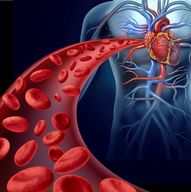
but if you weren’t lacing up your exercise footwear already – it also improves circulation which has a positive influence on the rate at which your body elimates toxins.
The body’s process of flushing toxins out of the body starts when your blood infiltrates the tissue. Exercise dramatically improves micro-circulation which in turn allows for greater exchange of all substances, meaning more nutrients in and more toxins out!
Conclusion
So there you have it, 10 top nutrition tips from a clinical nutritionist!
This can look like quite a daunting list of recommendations, but nobody is saying that you have to try to do all 10 every day (though you’d feel pretty amazing if you did!).
A more realistic approach would be select two or three which feel most suitable for you, whether it’s reducing your alcohol intake, drinking more water, eating more vegetables or simply exercising more!
Each small step you take will help you on your journey to a healthier you, so what are you waiting for…?
FACT – Being and feeling well we can all be the best we can be and enjoy life to its’ fullest.
Know someone who needs to improve their health?
Maybe you know someone who simply doesn’t know how their diet is affecting them?
Or that could benefit from expanding their knowledge of the food they eat?
Then why not share this post on Facebook? 🙂
References:
[1] What is Clinical Nutrition?[2] Making Sense of All Those Confusing Degrees and Credentials
[3] Major Pesticides Are More Toxic to Human Cells Than Their Declared Active Principles
[4] The Problem with Pesticides
[5] The effects of a double blind, placebo controlled, artificial food colourings and benzoate preservative challenge on hyperactivity in a general population sample of preschool children
[6] Semen quality of fertile US males in relation to their mother’s beef consumption during pregnancy

